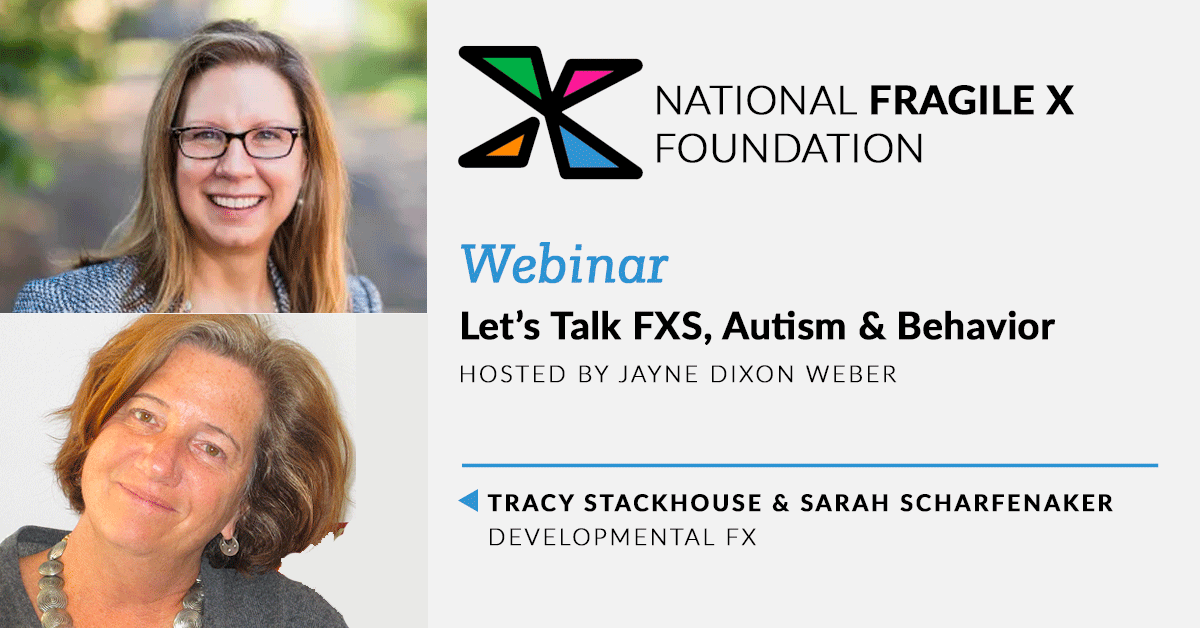By Tracy Murnan Stackhouse and Sarah Scharfenaker
Source: Developmental FX
As therapists working within the Fragile X community, we have been entrusted by parents to provide state-of-the-art services to their children. We are held accountable to understand the learning style of children with FXS, and how to best teach to that style. One of our presentations at the Atlanta conference was Fragile X Syndrome: Strategies for Day-to-Day Life. It outlined an assortment of strategies that are drawn from evidenced-based practice and knowledge of the neurocognitive development of children with FXS. This article is a synopsis of that presentation. We’ve included some handouts that we think you’ll find helpful as well. Cheers!
Children with Fragile X syndrome are often anxious and overwhelmed in a variety of situations. They may fall apart during a transition that they had no trouble dealing with the day before; they may resist a simple change in routine for no apparent reason; they may have a very successful day at school only to come home and bite or spit at Mom. These behaviors are typically not volitional or willful. Instead, they stem from the serious anxiety and arousal issues inherent to this disorder. Hyperarousal can lead to fear and a fight-or-flight state, causing the child to aggress, hide, run away, or refuse to comply with a request. With children in this state, we often observe diminished access to language, making it hard for them to communicate their feelings or needs at the moment.
However, we find that many of these challenging behaviors can be managed with various strategies that are mindfully integrated throughout the day. These strategies require a team to develop and have the most impact when followed throughout the child’s day. The strategy can be broken down into three areas: Sensory-Based, Routines-Based, and Language-Based.
Sensory-Based Strategies
One of the most fundamental sensory-based strategies is the sensory diet. A sensory diet is an occupational therapy intervention devised to attain and maintain appropriate arousal states throughout each day. A sensory diet consists of a carefully planned program of specific sensory-motor activities that is scheduled according to each child’s individual needs (Wilbarger & Wilbarger, 2002) and each family’s schedule and resources. Like a diet designed to meet an individual’s nutritional needs, a sensory diet consists of specific elements designed to meet the child’s sensory integration needs. It is based on the notion that controlled sensory input can affect one’s functional abilities.
Martin (1991) states in Principles of Neuroscience: “Sensory systems are not only our means for perceiving the external world, but are also essential to maintaining arousal, forming our body image and regulating movement.” Wilbarger & Wilbarger’s (2000) comprehensive approach to treating sensory defensiveness includes education and awareness, a sensory diet, and other techniques. One is the “Wilbarger Protocol” or “Therapressure” technique, which uses deep pressure on certain parts of the body, followed by joint compressions. These techniques employ the proprioceptors (sensory end organs that are sensitive to stimuli) as the source of sensory input.
The Wilbargers also suggest a specific protocol for addressing oral sensory defensiveness. Either of these strategies is used in combination with an overall sensory diet, which integrates sensory-motor activity into the life routine of the individual it is designed for. It is critical that this protocol not be used in isolation, and that it is initiated and monitored by an appropriately trained occupational therapist.
The How Does Your Engine Run? program (Williams & Shellenberger, 1994) is a step-by-step curriculum that teaches children simple changes to their daily routine (such as a brisk walk, jumping on a trampoline before doing their homework, listening to calming music) that will help them self-regulate or keep their engine running “just right.” Through the use of charts, worksheets, and other activities, the child is guided in improving awareness and using self-regulation strategies.
The use of this program greatly enhances the overall structure and effectiveness of the sensory diet.
We know that difficulties with sensory integration can have a profound effect on participation in everyday childhood “occupations”-play, school, and family activities. Collaboration between the therapist, teacher, and parents is the most efficient way to understand the child’s behavior and unique sensory needs. The “therapist-teacher-parent” team must work together to successfully implement a sensory diet and support the child’s performance across multiple environments.
Typically, a sensory diet is best designed by the family and therapist together. The therapist utilizes the direct treatment time to learn the individual child’s “formula” for attaining and maintaining appropriate sensory reactivity and arousal modulation. An example of a Sensory Diet Schedule is outlined below. Note: The following techniques should be done only under the supervision or with the consultation of an occupational therapist.
Five-Finger Approach
We can teach children and adults with FXS to recognize their hyperarousal and anxiety and to counteract them with the “Five Finger Approach.” This approach provides a portable and highly visual cue that we always have with us. We can assign a purpose to each of our five fingers and use the first two, or all five, depending on what fits each child. The Five Finger Approach can either be modeled by the adult on their own hand or demonstrated on the child’s hand, or modeling and demonstration can be combined.
When the child becomes upset, overwhelmed, or needs to settle down, you:
- Grab your thumb with your other hand. This is a signal to Stop! (You can also verbalize “Stop!” or say, “I need to settle.”)
- Next, grab your index finger. This is a signal to take a “Deep breath.” (You can say, “Deep breath!” or “Blow hard!”)
- Grab your middle finger and ask, “What do I need to do?” (This is the time to identify that they are out of sorts and need to settle-“I am mad and I need to relax,” or “I am mad and need to tell you.”)
- Grab your ring finger and ask, “How Do I Do It?” (What strategy needs to be used? What kind of oral motor, movement, touch, or visual input is preferred by the child to move into a more optimal state? You must be aware of this ahead of time.)
- Grab your pinky and say, “Do It!” Then, “do” whatever strategy was selected at the ring finger step.
While the Five Finger Approach requires self-awareness, many other strategies can be implemented.
Remember, of course, that these must be done under the supervision of an occupational therapist.
Ready–Not-Ready Cueing
We also like to have a way for children to communicate if they are “ready” or “not ready” for the next activity, event, or interaction (demand). This helps them learn to identify their “state” of preparation or readiness for the next demands or challenges. The nice thing about this strategy is that it takes the focus off the children “not being ready” for a new activity and helps them learn how to get themselves ready (prepared) for the next task. The children are cued using visuals and modeling. The goal is to help them learn to indicate when they’re not ready, which signals a need for them to get ready. Therein lies the seed of their self-regulation!
Ready–not-ready cueing helps children move toward larger adaptation and coping skills. A final important point: “Not ready” doesn’t mean, “I don’t have to do this.” Rather, it means, “I have to get ready to do this.”
We use visual support to mark “ready” or “not ready.”

It is also important to provide sensory-based coping strategies and a clear model for use of these techniques as a means for the child to move from a “not ready” to a “ready” state.
In learning what “ready” and “not ready” mean, the child should have lots of exposure to the visuals and concepts. Make sure you catch your child meeting various daily demands and then indicate that he or she was “ready!” This way, they will learn what “ready” means. Also, use the visuals yourself, and when you find yourself not ready for something, label it, talk about it, and teach your child through your own experience. Always pair “not ready” with clear examples of coping and preparing for getting ready to meet the demands of the situation.
Routine-Based Strategies
Another avenue for keeping the day organized is routine-based strategies, which help keep anxiety about the uncertain and other arousal sources at bay. We know that children with FXS may become:
- Disorganized during transitions.
- Upset when new activities are presented.
- Distressed when activities are altered.
- Upset when an activity does not have a defined beginning and end.
Visually-based schedules are integral to maintaining predictability, indicating changes, and specifying the “beginning” and “end” of an activity or event. Visual schedules can be complex or simple, portable or stationary, and used with real objects, pictures, or icons.
Some excellent resources for visual schedules can be found at the following websites:
The work process systems designed by TEACCH are another practical-routines-based strategy geared towards making the process of “work,” be it academics, play, or vocational activities, highly visual, with a defined beginning and end. Again, the predictability and visual aspects of a work process help reduce the arousal and anxiety that come with the child wondering “How much work do I have to do?… How will I know when I’m done?… What do I do next?” Work processes can be comprised of a series of baskets, a vertical stack of drawers, or any assortment of containers that help to visually designate the answers to those questions.
Language and social supports round out the day-to-day strategies that we use to minimize the range of life stressors associated with FXS. Our friend and colleague Marcia Braden, PhD, has made tremendous contributions to the world of Fragile X. Her understanding of the learning style of children with FXS and her ability to develop interventions based on that understanding is unparalleled. Marcia suggests that language-based supports be modified to capitalize on the learning strengths of individuals with FXS. Specifically, her description of “incidental learning” is a feature we have found can be capitalized on for day-to-day support. This learning style is characterized by children appearing uninvolved in a learning situation and physically placing themselves at a distance from the activity. But in reality, they are absorbing the information being presented. We can take advantage of this learning style when trying to shape or change behaviors through specific language and social-based strategies, including side dialogues, social stories, and video modeling.
For example, when the target child is in the vicinity, two adults can have a “social story” type of conversation, what we call a “side dialogue,” to identify a situation or problem, and define options for behavior in that activity. A 14-year-old we saw often spit at clinicians when he found work too challenging.
During a snack break, while the youth was playing with legos, two adults had a conversation similar to the one that follows:
Adult 1: Sometimes my work is hard; it makes me mad and frustrated.
Adult 2: Sometimes MY work is hard, too. When I get mad, sometimes I spit. I don’t WANT to spit, but I don’t know what else to do.
Adult 1: Hey, maybe you could say, “I’m mad, this is hard!” Or you could say, “Someone help me, this is hard!”
Adult 2: Those are good ideas. I will try to say, “I am mad, this is hard” and not spit.
The client was listening and processed this information during break time. Subsequently, he was observed during work using some self-talk: “I will not spit, I am mad!” Social stories, developed by Carol Gray, are another language support that can be used to increase predictability, thus decreasing anxiety and possible hyperarousal. When we join Marcia to see new children at consultation clinics, we send off a small modified social story before the first meeting as a way of decreasing the child’s anxiety about meeting new people. We usually add pictures of ourselves as well. The story we send follows:
“Hi ________ . Marcia, Tracy, and Mouse are VERY excited. They are going to see you in just ______ days! When we see you, we will play, look at books, and have a snack. See you soon!”
Video modeling is a bit like social stories on film! Through this technique, positive social and language models can be presented by important peers or adults in the child’s environment. The video can be observed, the behaviors imitated in role-play, and successful sessions can be videotaped, gradually moving from role-play to more realistic environments.
Our long experience with hundreds of families with FXS has led us to strongly suggest that all three types of strategies-sensory-based, routine-based, and language/ social-based-be integrated into daily life at home, school, and in the community. These strategies maximize coping and predictability while minimizing some of the common triggers for hyperarousal that, when not proactively managed, often result in poor behavioral adaptation.
author

Tracy Murnan Stackhouse, MA, OTR
Tracy Murnan Stackhouse is the co-founder of Developmental FX in Denver. She is a leading pediatric occupational therapist involved in clinical treatment, research, mentoring, and training regarding OT intervention for persons with neurodevelopmental disorders, especially Fragile X syndrome and autism. Tracy teaches nationally and internationally on sensory integration, autism, and Fragile X. Tracy is a member of the National Fragile X Foundation Clinical Research Consortium (FXCRC), the FXCRC Advisory Council, and the Scientific & Clinical Advisory Committee.
author

Sarah K. Scharfenaker, MA, CCC-SLP
Sarah K. Scharfenaker, fondly known as “Mouse,” is the now-retired co-founder of Developmental FX. She has worked in the fields of Fragile X syndrome and neurodevelopmental disorders for more than 25 years. She provided speech pathology services to the Denver Fragile X Treatment and Research Center at The Children’s Hospital in Denver, and accompanied Dr. Randi Hagerman to the UC Davis MIND Institute to initiate its program. She has a master’s in speech pathology from the University of Montana.
learn more
My Child is Home… Now What? Keeping a Routine — Webinar
In this webinar, Rebecca Shaffer guides us through the importance of having a routine, including providing predictability and lowering anxiety, and how to create and build your own for you and your child.
Letʼs Talk Fragile X Syndrome, Autism & Behavior — Webinar Replay
Developmental FX joins us to provide insight and advice on Fragile X and its connection to autism and behavior.



